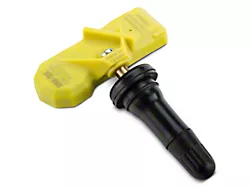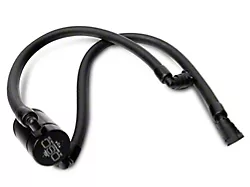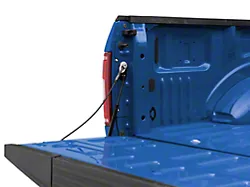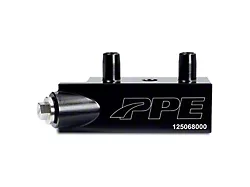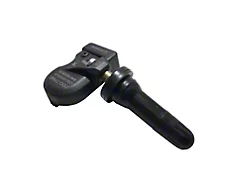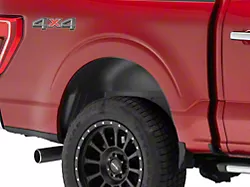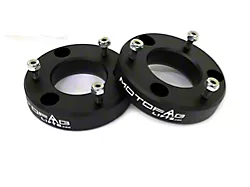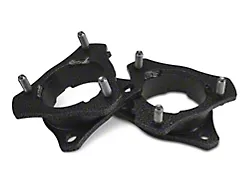
How to Install SuperLift 6.5 in. Suspension Lift Kit w/ Bilstein Shocks (07-13 4WD Silverado 1500) on your Chevy Silverado
Tools Required
- floor jack
- jack stands
- hammer
- plastic fastern removal tool
- die grinder w/cut-off wheel
- torque wrench
- 9/32" drill bit
- drill
- screwdriver
- adjustable pliers
- vise grips
- 5mm allen
- T30 torx
- 5/16" allen
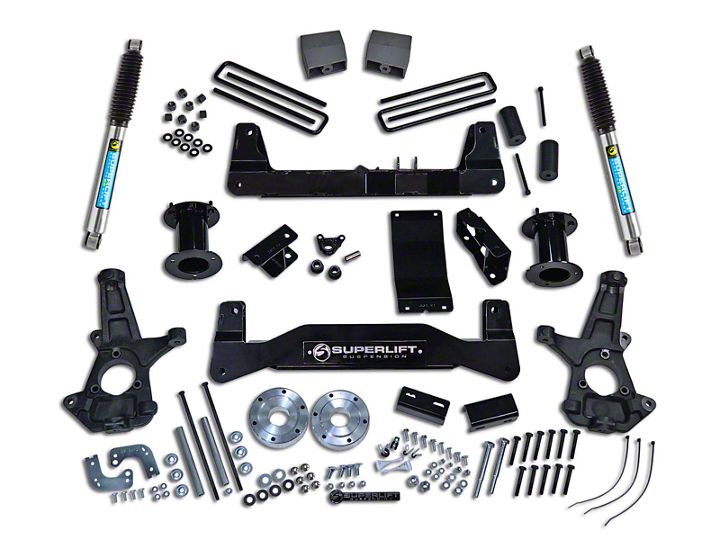
Shop Parts in this Guide

INTRODUCTION
Installation requires a professional mechanic.
Prior to beginning, inspect the vehicles steering, driveline, and brake systems, paying close attention to the suspension link arms and bushings, sway bars and bushings, tie rod ends, pitman arm, ball joints and wheel bearings. Also check the steering sector-to-frame and all suspension-to-frame attaching points for stress cracks. The overall vehicle must be in excellent working condition; repair or replace all worn parts.
Read instructions several times before starting. Be sure you have all needed parts and know where they install. Read each step completely as you go.
NOTES:
• Prior to beginning the installation, check all parts and hardware in the box with the parts list below. If you find a packaging error, contact Superlift directly. Do not contact the dealer where the system was originally purchased. You will need the control number from each box when calling; this number is located at the bottom of the part number label and to the right of the bar code.
• Do not fabricate any components to gain additional suspension height.
• Front end realignment is necessary.
• A foot-pound torque reading is given in parenthesis ( ) after each appropriate fastener
• Tool and Wrench/Socket size is given in brackets { } after each appropriate step.
• Prior to drilling or cutting, check behind the surface being worked on for any wires, lines, or hoses that could be damaged. Prep all cutting surfaces by removing all debris and frame coatings.
• After drilling, file smooth any burrs and sharp edges.
• Prior to operating a torch or saw, protect any heat-sensitive components located in the immediate area by covering them with a water-saturated cloth. Most undercoating are flammable but can be extinguished using a water-filled spray bottle. Have a spray bottle and an ABC rated fire extinguisher on hand.
• Paint or undercoat all exposed metal surfaces.
• Prior to attaching components, be sure all mating surfaces are free of grit, grease, undercoating, etc.
• A factory service manual should be on hand for reference.
• Use the check-off box o found at each step to help you keep your place. Two oo denotes that one check-off box is for the Driver Side (Left) and one is for the Passenger Side (Right). Unless otherwise noted, always start with the Driver Side.

FRONT DISASSEMBLY
Save ALL factory components and hardware for reuse, unless noted.
1) PREPARE VEHICLE...
Chock rear tires and place transmission in neutral. Raise front of vehicle with a jack and secure a jack stand beneath each frame rail. Ease the frame down onto the stands and place transmission in park. Remove front tires. {Lug Nuts 22mm}
Disconnect the Battery.
[Illustration 1] Remove any factory skid plates or belly pans that block access to front suspension components. {10mm, 15mm}
2) SWAY BAR BODY AND LINKS...
[Illustration 2] On each side, loosen and remove the bushings and hardware attaching the sway bar link to the lower control arm and the sway bar body. {15mm}


[Illustration 3] Remove the bolts securing the sway bar to the frame and remove the bar. {10mm} Note the orientation of the sway bar for reference during reassembly. Bushing with washer top, bushing, extension, bushing, bushing with washer bottom.
Perform Steps 3-12 One Side At A Time. Start on the Driver Side and Complete Steps 3-12. THEN go to the Passenger Side and Complete Steps 3-12.
3) STEERING TIE ROD END...
[Illustration 4] Remove the nut from the tie rod end and using the appropriate puller tool, remove tie rod from knuckle. If you do not have a puller tool you can use a hammer, by very carefully striking the tie rod boss of the knuckle; do not strike the tie rod end. {21mm}
4) BRAKE LINE BRACKET AND ABS SENOR WIRE...
[Illustration 5] Unclip the ABS lines from the brake line bracket on the upper control arm. {plastic fastener removal tool}
[Illustration 6] Unclip the ABS lines from the brake line bracket located on the frame. {plastic fastener removal tool}



[Illustration 7] Locate the brake line bracket on the steering knuckle and remove. {10mm)
[Illustration 8] Unbolt the brake line bracket from the upper control arm. {10mm)
5) BRAKE CALIPER...
[Illustration 9] Unbolt the brake caliper and remove from the rotor and secure it away from the work area. Illustration 7 Do not let calipers hang from brake lines. Using a bungee strap, wire hook or wire, safely secure the calipers to the frame to remove the tension from the brake lines and to add working room. {18mm)
[Illustration 10] Remove the torx bolt retaining the rotor to the hub assembly, remove the brake rotor, and set it aside. {T30)
6) ABS SENSOR...
[Illustration 11] Unbolt and remove the ABS sensor from the hub assembly. {5mm allen)



7) CV AXLE SHAFT NUT...
For 2WD systems, skip this step & proceed to the next step. (You don’t have front axles).
[Illustration 12] Remove the nut & washer securing the axle shaft to the hub assembly. {35mm}
8) KNUCKLE...
[Illustrations 13 & 14] Remove the nuts from the upper and lower ball joints, then using the appropriate puller tool, disconnect the ball joints from the knuckle. If you do not have a puller tool you can use a hammer by very carefully striking the ball joint boss’ of the knuckle; do not strike the ball joints. Remove knuckle from vehicle. {upper ball joint 18mm, lower ball joint 24mm}
9) LOWER CONTROL ARM...
[Illustration 15] Loosen but do not remove the four lower control arm bolts (2 per side). {bolt 18mm, nut 24mm}
10) STRUT REMOVAL...
[Illustration 16] Remove the two bolts securing the strut to the lower control arm; allow the lower control arm to hang, while you move to the upper strut mount. {15mm}



[Illustration 17] Unclip the wire clips located on the top of the studs. {plastic fastener removal tool}
[Illustration 18] Remove three nuts securing the strut to the frame then remove the strut. {18mm}
11) AXLE SHAFT...
For 2WD systems, skip this step & proceed to the next step.
[Illustration 19 & 20] Mark the location of the CV axle shafts (driver and passenger side) for later reference during reassembly. Remove the six bolts that attach the axle shaft to the CV flange on the differential. {15mm} Remove the axle shaft from the vehicle and set aside.
12) LOWER CONTROL ARM...
[Illustration 21] Remove the lower control arm’s bolts from the front & rear crossmembers. NOTE: Once you loosen the control arm’s bolts, the weight of the arm is going cause it to drop/swing down quickly. Remove the lower control arm. {24mm & 21mm}
Repeat steps 3 through 12 on the Passenger Side.




13) REAR CROSSMEMBER...
[Illustration 22] Remove the rear crossmember from the frame and discard. {18mm)
14) FRONT DRIVESHAFT...
NOTE: For 2WD systems, proceed to step 18.
[Illustration 23] Mark the orientation of the driveshaft for reference during reassembly. Remove the four bolts securing the driveshaft. Secure the driveshaft up and out of the way. {11mm)
15) RACK AND PINION STEERING...
NOTE: The Rack & Pinion Steps ONLY occur in 2014-2017 Models. 2007-2013 Vehicles, Skip this Step & Proceed to Step 16.
[Illustration 24] Mark the orientation of the steering shaft and pinion shaft for later reference during reassembly.
[Illustration 25 & 26] Remove the bolt securing the steering shaft to the pinion shaft, then remove the steering shaft from the pinion shaft. {11mm)


[Illustration 27] IF equipped with electronic power steering, unplug the two (2) connectors. WITH the Battery Disconnected, carefully unplug the bottom two plugs from the rack and pinion. These plugs are “locked” with plastic clips that must be moved to an “unlocked” position before removal. The wire loom is connected to the differential in several places, make sure these are un-clipped before removal of differential. {plastic fastener removal tool}
[Illustration 28] Support the rack and pinion with a jack. Remove the four bolts securing the rack and pinion to the frame, then carefully remove the rack and pinion from the vehicle. {driver side 24mm, passenger side 18mm}
16) DIFFERENTIAL REMOVAL...
[Illustration 29] Remove the electrical plug, wire loom, and vent hose from the differential.
Support the differential housing with a jack.


[Illustration 30 & 31] Remove the two differential mounting bolts on the driver side, followed by the two nuts on the passenger side. Carefully lower the differential housing to the floor. {driver side 18mm, passenger side 21mm}
17) DIFFERENTIAL TRIMMING...
This Trimming is for 2014-2017 Vehicles ONLY!
DO NOT Trim 2007-2013 Vehicles.
If 2007-2013 Vehicle, Proceed to step 18.
[Illustration 32 & 33] On the Passenger Side of the differential, measure from the back edge of the front slot towards the rear 0.75” and mark a line that runs parallel with the differential all the way across the tab then out to the front. Using a band saw, reciprocating saw, or similar tool, cut the front differential tab off. TAKE EXTREME CAUTION!! DO NOT CUT INTO THE DIFFERENTIAL MAIN TUBE!!
Trim the mount AND the area up to the flange as marked.
[Illustration 32 & 33] Continuing on the Passenger Side of the differential, measure from the back edge of the rear slot towards the rear 0.50” and mark a line that runs parallel with the differential. Using a band saw, reciprocating saw, or similar tool, trim the rear differential tab.
This Trimming is for 2014-2017 Vehicles ONLY! DO NOT Trim 2007-2013 Vehicles.



18) TRIMMING THE FRAME...
[Illustration 34] On Each Side, trim the inside corners of the factory front lower control arm pockets enough to facilitate installing the (55-05-3492) front crossmember. It is only necessary to square off the radius present in the pockets. Test fit the “05” crossmember and trim accordingly.
Once you are happy with the fit, deburr the edges and apply a coat of paint to prevent rust.
[Illustration 35] On the Driver Side lower control arm mount, measure over 0.556” from the edge of the lower control arm mount hole and mark. Mark the cut line all the way around the mount. Using a torch, plasma cutter, or similar tool, trim the Driver Side lower control arm bracket.
When using a torch or plasma cutter, beware of the sticky, waxy undercoating - cosmoline. This will melt and drip during the cutting process. Take precautions to cover your person and the floor from this extremely HOT material.
Once you are happy with the cut, deburr the edges with a grinder and apply a coat of paint or undercoating to prevent rust.
[Illustration 36] On BOTH the Driver and Passenger Side, trim the front lip of the rear lower control arm mount. Once you are happy with the trim, deburr the edges with a grinder and apply a coat of paint or undercoating to prevent rust.



FRONT ASSEMBLY
NOTE: For 2WD systems, Proceed to Step 24.
19) RACK AND PINION STEERING...
[Illustration 37] Apply thread locker to the factory bolts and carefully reattach the rack and pinion to the frame reusing the four bolts; tighten. (Driver Side 321) (Passenger Side 232) {Driver Side 24mm, Passenger Side 18mm}
Reroute the wire loom to the original locations and reattach to the connectors on the differential. Make sure to “lock” the clips.
[Illustration 38] Realign the marks on the steering shaft and pinion shaft and attach using the factory hardware; tighten. (26) {11mm}
20) PASSENGER SIDE DIFFERENTIAL BRACKET...
2007 - 2013 VEHICLES
[Illustration 39 (For Reference ONLY; 55-04-3492 Shown)] Looking at the Passenger Side differential bracket (55-18-3492), you will notice it has a taper and a radius cutout; the “tall” end of the taper should be positioned forward (toward the front bumper), while the “short” end of the taper should be positioned rearward (toward the rear bumper). Attach the “18” bracket to the factory passenger side differential mount using the factory hardware. Do not tighten at this time. {21mm}
2014 - 2017 VEHICLES
[Illustration 39] Looking at the Passenger Side differential bracket (55-04-3492), you will notice it has a taper and a radius cutout; the “tall” end of the taper should be positioned forward (toward the front bumper), while the “short” end of the taper should be positioned rearward (toward the rear bumper). Attach the “04” bracket to the factory passenger side differential mount using the factory hardware. Do not tighten at this time. {21mm}
21) DRIVER SIDE DIFFERENTIAL BRACKET...
[Illustration 40] Note that the driver side differential bracket (55-03-3492) has a taper in it as well; position the bracket so that the tall end of the taper faces forward (to match the taper of the passenger side bracket). Also note there is a notch in the center of the bracket that accommodates a tab in the center of the factory differential mount. Attach the “03” bracket to the factory mount using the factory bolts. Do not tighten at this time. {18mm}




22) DIFFERENTIAL INSTALL...
[Illustration 41] Using a jack, raise the differential into position and line up the mounting holes with the “03” and “18 or 04” drop brackets. Attach the differential on the Driver Side using the supplied 1/2” x 1-3/4” bolts, washers, and nuts. Do not tighten at this time. {3/4”}
[Illustration 42] Attach the Passenger Side of the differential to the “18 or 04” bracket using the supplied 5/8” x 1-3/4” bolt(s), washer(s), and nyloc nut(s). The bolt(s) should be installed from the top, and the extra-thick flat washer(s) should be positioned under the nut(s). Do not tighten at this time. {15/16”}
NOTE: Check the clearance on the Driver Side lower control arm mount where you trimmed the factory mount. Trim more if needed. Check the clearance on the Passenger Side between the differential mount bracket, the differential and/or rack and pinion. It is easier to remove the differential now & trim than to do it after everything is installed.


[Illustration 43] Reconnect the differential wiring. Attach the supplied vent hose extension to the factory vent hose and reconnect it to the differential.
23) REAR DIFFERENTIAL MOUNT...
[Illustration 44] On the rear passenger side of the differential remove the first and second bolt below the drive shaft. {15mm}
[Illustration 45] Press the two polyurethane bushings and sleeve into the eye ring of the new differential bracket (55-07-3492). Install the bracket with the orientation feature pointing rearward, using the factory hardware. Do not tighten at this time. {15mm}

24) FRONT CROSSMEMBER...
[Illustration 46] Attach the front crossmember (55-05-3492) to the lower control arm frame mounts using the supplied 5/8” x 4-1/2” bolts, washers, and nyloc nuts. The bolts should be installed from the front. Note that the crossmember should be positioned so that the mounting tab for the differential skid plate points rearward. Do not tighten at this time. {15/16”}
25) REAR CROSSMEMBER...
[Illustration 47] Install the rear crossmember (55-06-3492) to the lower control arm mounts, making sure the rear differential bracket is installed correctly into the tabs on the rear crossmember. Secure to the frame using the supplied 5/8” x 5-1/2” bolts, washers, and nyloc nuts. The bolts should be installed from the front. Do not tighten at this time. {15/16”}
NOTE: 2WD systems, proceed to next step.
[Illustration 48] Attach the rear crossmember to the rear differential bracket using the supplied 1/2” x 3-1/4” bolt, washers, and nyloc nut. Do not tighten at this time. {3/4”}
26) LOWER CONTROL ARMS...
[Illustration 49] Attach the lower control arm to the front and rear crossmembers using the factory hardware. The bolts should be installed from the front. Snug, but do not tighten the hardware at this time. {bolt 18mm, nut 24mm}



27) TIGHTEN THESE FASTENERS...
Tighten the following hardware in this order. Refer back to the illustrations listed if needed.
[Illustration 40] Factory bolts on driver side frame to differential bracket (87) {18mm}
[Illustration 39] Factory nuts on the passenger side frame to differential bracket (75) {21mm}
[Illustration 41] 1/2” hardware driver side differential to differential bracket (76) {3/4”}
[Illustration 42] 5/8” hardware passenger side differential to differential bracket (150) {15/16”}
[Illustration 48] 1/2” hardware rear differential mount to rear crossmember. (76) {3/4”}
[Illustration 46] 5/8” hardware front crossmember to frame. (150) {15/16”}
[Illustration 47] 5/8” hardware rear crossmember to frame. (150) {15/16”}



28) BELLY PAN...
NOTE: For 2WD systems, proceed to Step 30.
[Illustration 50] Attach the belly pan (55-08-3492) to the front and rear crossmembers using the supplied 3/8” x 1” carriage bolts and flange nuts; tighten. (23) {9/16”}
29) DRIVESHAFT...
NOTE: For 2WD systems, proceed to Step 30.
[Illustration 51] Apply thread locker to the factory hardware, then line up the front driveshaft with the differential yoke according to the marks made during removal and secure using the factory hardware. Tighten (19) {11mm}
NOTE: If installing SUPERLIFT Edition KING Coilovers; Install Using Separate Instructions Included in the KING Kit Box Then Move to Step 31.
30) STRUT SPACER...
[Illustration 52] Attach the new strut spacer (55-10-3492) to the top of the strut assembly using the factory hardware and tighten the factory nuts. (37) {18mm}
[Illustration 53] Slide the strut assembly through the upper control arm and locate the upper end of the assembly into the frame mount properly. Secure the upper end of the assembly using the supplied 10mm flange nuts. Do not tighten at this time. {15mm}
[Illustration 54] Attach the lower end of the strut to the lower control arm using the factory hardware and tighten. (37) {15mm}
[Illustration 55] Tighten the top strut 10mm nuts. (37) {15mm}

31) AXLE SHAFT SPACER...
NOTE: For 2WD systems, proceed to the next step.
[Illustration 56 & 57] Position an axle shaft spacer (66-15-3330) between the flange on the axle shaft and the flange on the differential and secure using the supplied 10mm x 70mm bolts and flat washers. Put thread locker on the bolts before installing. Tighten (58) {17mm}
32) KNUCKLE ASSEMBLY...
Perform These Steps on One (1) Knuckle at a Time.
[Illustration 58] Note the orientation of the dust shield and wheel bearing assembly prior to removal. Remove the three bolts securing the wheel bearing assembly to the factory knuckle.
[Illustration 59 & 60] Install the new knuckle (66-01-3492 or 66-15-3492 Driver Side; 66-02-3492 or 66-16-3492 Passenger Side) onto the factory bearing assembly and dust shield using the factory hardware. Be sure the orientation of the dust shield and bearing assembly matches original. Use the supplied thread locker on the three factory fasteners. Tighten (151) {15mm}



33) KNUCKLE INSTALLATION...
[Illustration 61] Install the knuckle assembly on the lower ball joint while sliding the CV shaft into the new knuckle. Connect the upper ball joint to the knuckle and secure using the factory nuts. Tighten the lower nut (94) and the upper nut (37) {upper ball joint 18mm, lower ball joint 24mm}

34) AXLE SHAFT...
[Illustration 62] Secure the axle shaft to the knuckle with the factory nut and tighten. (148-165) {35mm}
35) BRAKE LINE BRACKET...
[Illustration 63] Remove the factory brake line bracket from the frame located on the rearward side of the upper control arm mount. {13mm}
[Illustration 64] Attach the brake line relocation bracket (55-09-3492) to the factory brake line location on the frame. Secure using the factory hardware in the factory hole and use the supplied 3/8” x 3/4” bolt, washer, and nyloc nut in the lower hole and tighten. (factory bolt: 76 in-lb; 3/8” bolt 30) {13mm,9/16”}
[Illustration 65] Fasten the factory brake line bracket to the new bracket using the supplied 1/4” x 3/4” bolt, washer, and nyloc nut. (8) {1/2”}
[Illustration 66]
CAUTION: DO NOT DAMAGE BRAKE HOSE.
Use a pair of vise grips and adjustable pliers to pry open the factory brake line bracket, that attached the hose to the top of the control arm, free from the brake hose. Clamp the vise grips so they are gripping the edge and the back side of the radius, as shown. Then using the adjustable pliers, pry the bracket free. {vise grips, adjustable pliers}



36) ABS WIRING...
[Illustration 67 & 68] Route the ABS wiring down from the frame on the rearward side of the knuckle to the hub assembly. If necessary, use a pry bar to pry the dust shield out of the way to install the ABS sensor into the hub assembly.
Secure the ABS sensor to the hub assembly using the factory hardware. (1) (5mm allen)
[Illustration 69] Place the supplied 3/8” Adel clamp over the factory rubber grommet located on the lower end of the ABS line and fasten it to the knuckle in the lower hole using the supplied 1/4” x 3/4” bolt. (8) {7/16”}
[Illustration 70] Place the supplied 1/4” Adel clamp over the ABS line and fasten it to the knuckle in the upper hole using the supplied 1/4” x 3/4” bolt. (8) {7/16”}
37) BRAKE ROTOR...
[Illustration 71] Install the brake rotor and secure it using the factory Torx bolt and tighten. (106 in-lb) {T30}



38) BRAKE CALIPER...
NOTE!! Trucks equipped with a factory Aluminum knuckle must use the supplied 14mm thick washer on the factory brake caliper bolts. Place the washer between the head of the bolt and the knuckle. If they are not used, the bolt may interfere with the brake rotor.
[Illustration 72A & 73B] Apply the supplied thread locker to the factory caliper bracket bolts. Attach the caliper bracket assembly to the knuckle and tighten. (129) {18mm}
39) STEERING TIE ROD END...
[Illustration 73] Attach the tie rod end to the knuckle; tighten. (44) {21mm}
40) SWAY BAR BRACKETS...
[Illustration 74] Attach the sway bar drop brackets (55-11-3492) to the factory sway bar mounts on the frame using the supplied 10mm x 30mm bolts and flat washers. Note that the flat side of the bracket should face the outside of the vehicle and the sway bar body is shifted rearward. Do not tighten at this time.
[Illustration 74] Attach the anti-sway bar body to the new drop brackets using the factory bolts supplied and 10mm stover nuts. Do not tighten at this time.
Tighten the upper hardware followed by the lower. (50) {upper 17mm; lower bolt 10mm, nut 17mm}
[Illustration 75] Locate the new 3/8” x 12” bolts, the new sway bar tube (12-3492) and washer packs (145098). Place a supplied washer over the bolt followed by a factory bushing and insert from the bottom-up through the lower control arm. Place another factory bushing and supplied washer on the bolt followed by the new sway bar link tube (12-3492), then a supplied washer and bushing.
Push bolt through the sway bar body, then top off with the last factory bushing, factory washer, and supplied 3/8” nut. Tighten until the bushings swell slightly.




41) TIRES / WHEELS...
[Illustration 76] Tighten the lug nuts (140) in the sequence shown.
WARNING: When the tires / wheels are installed, always check for and remove any corrosion, dirt, or foreign material on the wheel mounting surface, or anything that contacts the wheel mounting surface (hub, rotor, etc.). Installing wheels without the proper metal-to-metal contact at the wheel mounting surfaces can cause the lug nuts to loosen and the wheel to come off while the vehicle is in motion.
WARNING: Retighten lug nuts at 500 miles after any wheel change, or anytime the lug nuts are loosened. Failure to do so could cause wheels to come off while vehicle is in motion.
42) CLEARANCE CHECK...
With the vehicle still on jack stands, and the suspension “hanging” at full extension travel, cycle steering lock-to-lock and check all components for proper operation and clearances. Pay special attention to the clearance between the tires / wheels and brake hoses, wiring, etc.
Lower vehicle to the floor.
43) LOWER CONTROL ARM...
Tighten the lower control arm bolts. (129) {15/16”}
44) BATTERY...
Reconnect battery.
REAR ASSEMBLY
45) PREPARE VEHICLE...
Chock the front tires. Position a jack beneath the center of the rear axle of the vehicle. Raise rear of vehicle and place jack stands under the frame rails, a few inches in front of the rear springs’ front hangers. Ease the jack down until the frame is resting on the stands. Keep a slight load on the jack. Remove the rear tires.
46) EMERGENCY BRAKE CABLE...
[Illustration 77] Note the location of the brake cables within each hanger. Remove the emergency brake cable hangers from the frame. {13mm}
[Illustration 78] Unbolt the clamp on the driver side lower shock mount that secures the driver side emergency brake cable to the axle. {13mm}
[Illustration 79] Remove the clamp from the emergency brake cable; discard clamp. {adjustable pliers}



[Illustration 80 & 81] Disconnect the driver side emergency brake cable from brake adjuster at the frame. Collapse the prongs retaining the emergency brake cable in frame bracket and remove. Route the cable over the axle tube, then re-attach it to the frame mount and the adjuster. {vise grips, screwdriver}

47) ABS WIRING...
[Illustration 82 & 83] Unclip the plastic clips retaining the ABS wiring from the top and inside of the frame rail, as well as the clip on the axle. {plastic fastener removal tool}
48) SHOCK ABSORBERS
[Illustration 84] Remove the shock absorbers. Discard. {21mm}
49) BRAKE LINE BRACKET
[Illustration 85] Unbolt the rear brake hose bracket from the top of the driver side frame rail. This bracket secures the connection between the metal brake lines and rubber hoses at the frame. {13mm}

[Illustration 86] Carefully reform the metal lines so that the mounting foot for the bracket lines up with the bottom of the frame rail, directly below its original attachment point. Use extreme caution to avoid pinching or otherwise damaging the lines. Using the bracket as a template, mark the location of the new mounting holes to be drilled in the bottom of the frame.
Move the brake lines out of harm’s way and drill at the marked locations using a 9/32” bit. {drill, 9/32” drill bit}
[Illustration 87] Line up the bracket with the drilled holes and install the supplied 5/16” x 1” self-tapping bolts. Tighten. (10) {7/16”}
50) BUMP STOPS....
[Illustration 88] Unbolt the compression stops from their mounting cups; discard the hardware. {10mm}
[Illustration 89] Place the new spacer (55-20-3492) between the frame and the factory bump stop. Secure using the supplied 10mm x 140mm bolt and washer. (37) {8mm allen}
51) INSTALLING BLOCKS...
[Illustration 90] Remove ubolts and then lower the axle several inches away from springs; discard the ubolts, factory blocks, and hardware. {21mm}



[Illustration 91] Clean spring pads of all debris. Position the Illustration 91 Superlift block (55-02-201) on top of the axle pad with the tall end facing rearward, then using the floor jack(s), mate the springs to the blocks, be sure that the center bolt heads seat properly. Install the new Superlift 9/16” ubolts (10542) and factory ubolt plate. Evenly torque the ubolts using an “X” tightening sequence. (150) {7/8”}
[Illustration 91] Install the new SUPERLIFT 7/16” u-bolts (716x314x412ub) over the leaf spring and through the new block securing with the supplied 7/16” flange nuts. (70) {5/8”}
52) SHOCK ABSORBERS...
[Illustration 92] Install the rear shock absorbers; SUPERIDE shocks must be installed with the cylinder body mounted at the axle (Superide 01-85150; BILSTEIN BE5-6249-H5). Position a supplied 3/4” SAE washer at the top and bottom of the shock on the inside of the bracket and tighten the upper and lower bolts. (76) {21mm}
53) ABS WIRING...
[Illustration 93] Reattach the ABS wire to the axle and pull the ABS wire up from the axle along the rear ubolt and secure it to a ubolt using the supplied cable tie
[Illustration 94] Using supplied cable tie, secure the ABS wire to the bump stop mount.


54) EMERGENCY BRAKE CABLE...
[Illustration 95] Secure the emergency brake cable to the ubolt at the axle using the supplied cable tie.
55) TIRES / WHEELS...
[Illustration 76] Reinstall tires and wheels. Tighten the lug nuts in the sequence shown. (151) {21mm}
WARNING: When the tires / wheels are installed, always check for and remove any corrosion, dirt, or foreign material on the wheel mounting surface, or anything that contacts the wheel mounting surface (hub, rotor, etc.). Installing wheels without the proper metal-to-metal contact at the wheel mounting surfaces can cause the lug nuts to loosen and the wheel to come off while the vehicle is in motion.
WARNING: Retighten lug nuts at 500 miles after any wheel change, or anytime the lug nuts are loosened. Failure to do so could cause wheels to come off while vehicle is in motion.
Lower vehicle to the floor.

56) CLEARANCE CHECK...
With the vehicle on the ground, check all components for proper operation and clearances. Pay special attention to the clearance between the tires / wheels, brake hoses, wiring, etc.
57) WHEEL ALIGNMENT...
Realign vehicle to factory specifications. It is necessary to have a proper and professional wheel alignment performed by a certified alignment technician. Align the vehicle to factory specifications. It is recommended that your vehicle alignment be checked after any off-road driving.
58) HEADLIGHTS...
Re-adjust headlights to proper setting. In addition to your vehicle alignment, for your safety and others, it is necessary to check and adjust your vehicle headlamps for proper aim and alignment.
59) FOUR WHEEL DRIVE...
Activate the four wheel drive system and check for proper engagement.
60) SUPERLIFT WARNING DECAL...
Install the WARNING TO DRIVER decal on the inside of the windshield, or on the dash, within driver’s view. Refer to the “NOTICE TO DEALER AND VEHICLE OWNER” section below.

Important Maintenance Information
It is the ultimate buyer’s responsibility to have all bolts / nuts checked for tightness after the first 100 miles and then every 1000 miles. The steering, suspension and driveline systems, plus wheel alignment should be inspected by a qualified professional mechanic at least every 3000 miles.
